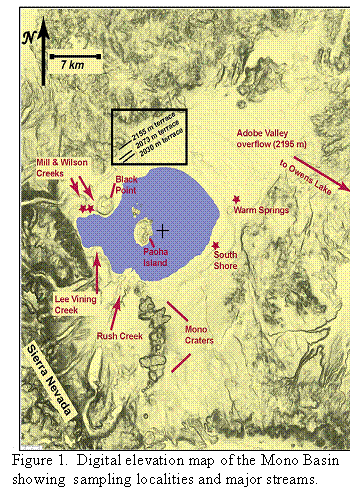
ACS PRF | ACS
All e-Annual Reports

42131-GB2
A Survey of Trace Element Concentrations in Lacustrine Carbonate Precipitates of the Western Great Basin, USA: Potential Proxies for Paleo-Lake Chemistry
The motivation of this project is to develop proxies of lake chemistry for salinity and alkalinity in order to study climate change in lake basins and, specifically, to produce a record of climate change in the Mono Basin of California. Lake basins are recognized as important continental archives of climate change, but developing tools to read these records is challenging. Figure SEQ Figure \* ARABIC 1. Digital elevation map of the Mono Basin showing sampling localities and major streams. The funding provided by the PRF starter grant has allowed support for the research projects of several students for whom I was the main advisor (Rahul Sahajpal- Ph.D. in progress CUNY, Crystal Pearl- Queens College MS, 2007) or informal co-advisor and collaborator (Susan Zimmerman- Columbia PhD 2006, Stephanie Searle- Columbia College Senior thesis 2007). Additionally, undergraduate student Corinne Hartin (now a PhD student at University of Miami) worked as a research assistant. The work is highly collaborative, including Sidney Hemming (Columbia), my former post doc Paul Tomascak (SUNY Oswego) and Neil Tibert (Mary Washington University). Besides financial support for students, resources provided by the ACS/PRF grant, combined with internal resources from CUNY, were used to fund a 5-week field excursion to the Mono Basin in the summer of 2005. We ran a field course for Queens College students Crystal Pearl and Lily Leon. Susan Zimmerman, Crystal Pearl and Stephanie Searle joined the team, and the group sampled the Warm Springs Section (Fig. 1). Samples were taken at 2 cm spacing and the several hundred samples represent the time interval between 40 and 14 ka. Corrine Hartin measured the calcium carbonate content (also replicating this interval from the Wilson and South Shore Sections). Stephanie Searle used these same samples for her senior thesis project at Columbia College. The field work provided a set of samples that several students have used for the overall goal of developing climate proxies in Mono Lake. These samples are now the basis for PhD student Rahul Sahajpal's research, and will be used by future Queens College students for future undergraduate research projects and graduate dissertations. With the help of two graduate students (Lily Leon and Rahul Sahajpal), and two undergraduate students (Sarah Kantz and Ajay Rambaran), we have developed a new technique for extracting rare earth elements (REE) from geologic samples using an ion exchange column coupled to a peristaltic pump system. This system has been tested on carbonate samples (corals) and has proven to be a clean and efficient method of sample preparation. Further, it is totally applicable to isolation of other elements for future work. The process involves spiking the sample with a mixed REE enriched isotope tracer, dissolving the sample in nitric acid, passing the sample through the ion-exchange system to isolate the REE, and analyzing the REE concentrations by isotope dilution using a single collector, high resolution ICP-MS. Work continues to ground truth the application of REE concentrations in carbonates as an alkalinity proxy. Towards this end, I have collected water samples from Mono, Walker and Pyramid Lakes, and modern precipitates from Mono Lake and gastropod shells from the shallow water of Pyramid Lake. We have also collected more than 100 tufa samples and have cleaned, spiked (with a mixed REE and U and Th spike), dissolved and processed an initial batch of 20 to isolate heavy REE, light REE, Th and U fractions for analysis. Over the last year, graduate student Rahul Sahajpal has concentrated his research on salinity proxies. Since developing an ICP-AES technique for analyzing Li/Ca, Mg/Ca, and Sr/Ca in lake sediments, he has been analyzing data from over 250 sediment samples from Mono Lake, California. These samples range from modern to 40,000 years old. Because Mono Lake levels (and thus salinity of this closed basin lake) have fluctuated dramatically with changes in precipitation over that period, proxies of salinity/lake level can provide a valuable record of regional precipitation changes. Rahul's results show that indeed there is a correlation between Li/Mg and lake level, and he is now putting that record into a global climate context (AGU Fall Meeting Abstracts, 2007). This work was facilitated by ACS/PRF SUMR scholar Luis Deverez, who worked with Rahul preparing samples for analysis. In addition, Luis worked with Professor Gillian Stewart in our department, who works on Polonium isotopes as an indicator of particle flux, a potentially important tool for understanding processes that effect lake chemistry. Overall, this funding has been a major benefit towards my efforts to initiate new projects and to involve students at all levels in exciting research. I expect that this grant will be credited in at least four peer-reviewed papers, two led by Susan Zimmerman, one by Rahul Sahajpal, and one on REEs where I will take the lead. 